

Meet the Leaders
Général Comte Antoine-Charles-Louis LaSalle
by Colonel Baron Bill Peterson
"...an officer of the highest merit, and one of our best light cavalry generals" - Napoleon
"A hussar who is not dead at thirty is a poltroon." - LaSalle

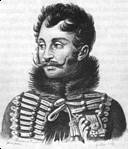
LaSalle stands out as one of the most popular cavalry leaders of the Napoleonic era, a beau sabreur with all of the panache of a Murat, without the latter's extravagance and vices. Son of a military pay commissioner, Antoine-Charles-Louis was born in Metz on the 10th of May, 1775. He was appointed Sous-Lieutenant in the Régiment d'Alsace-Infanterie in June 1786, at the remarkable age of 11. He transferred to the 24ème Régiment de Cavalerie in May 1791, but resigned his commission in 1792.
Drafted into the army of the Revolution in 1793, LaSalle was a simple trooper in the 23ème Régiment de Chasseurs à Cheval in the Army of the North until promoted to maréchal des logis (Sergeant) in March 1794, then Lieutenant in March 1795.
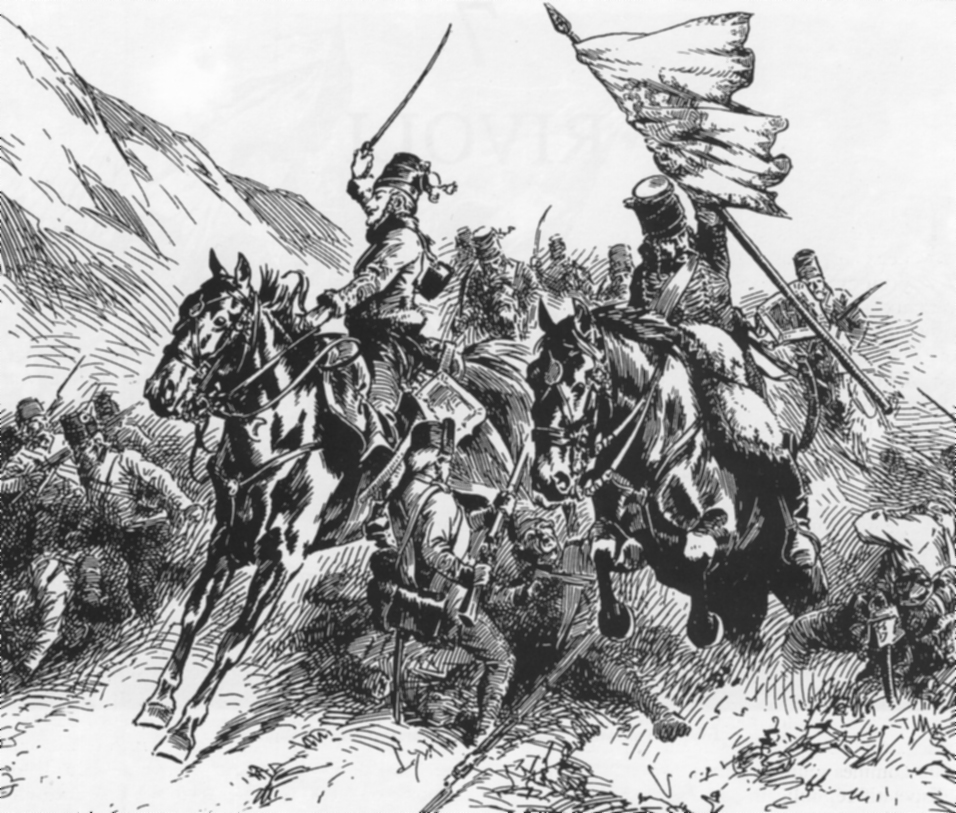
LaSalle entered Bonaparte's orbit with his transfer to the Army of the Alps in May 1795, and then the Army of Italy in May 1796. He was captured by the Austrians in their raid on the French depot at Brescia, 29 July 1796, but soon liberated. Promoted to Capitaine on 7 November 1796, he fought with distinction at Vicenza in December. Provisionally named Chef d'Escadron
by Bonaparte on 6 January 1797, the 21-year-old LaSalle entered legend with his brilliant performance at the Battle of Rivoli, 14 January 1797.
 LaSalle's squadron of the 7e bis Hussards charged and captured an entire Austrian battalion in the Osteria Gorge. In the aftermath of the battle, as victorious French soldiers were piling captured Austrian standards at Napoleon's feet, it is said that he turned to the exhausted LaSalle and said, "Couche-toi dessus, tu l'as bien mérité" (lie down on those, you have certainly earned it).
LaSalle's squadron of the 7e bis Hussards charged and captured an entire Austrian battalion in the Osteria Gorge. In the aftermath of the battle, as victorious French soldiers were piling captured Austrian standards at Napoleon's feet, it is said that he turned to the exhausted LaSalle and said, "Couche-toi dessus, tu l'as bien mérité" (lie down on those, you have certainly earned it).
LaSalle distinguished himself at the crossing of the Piave on 13 March, and suffered several saber wounds at the crossing of the Tagliamento on 16 March, 1797. His appointment as Chef d'Escadron was confirmed by the Directory on 22 April, 1797.
Serving with the Army of the Orient, LaSalle fought brilliantly at the Battle of the Pyramids on 21 July, 1798; in recognition of his merits, he was provisionally named Chef de Brigade and given command of the 22e Chasseurs à Cheval on 23 July, at the age of 23.
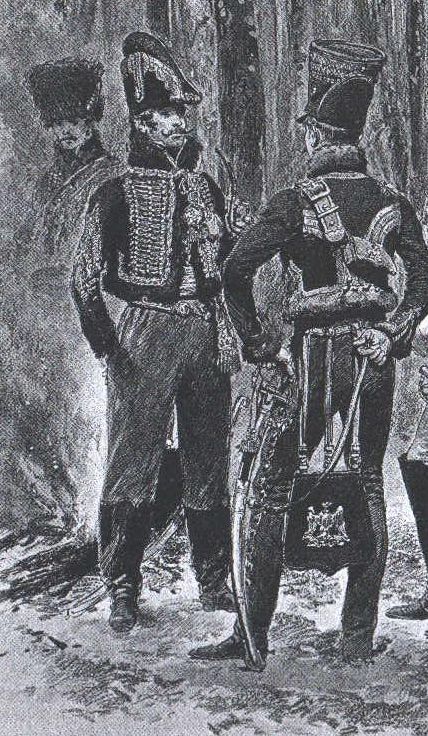 He is credited with saving the life of Davout at the Battle of Redemieh on 17 January, 1799. Returning to France in early 1800, LaSalle was confirmed in the rank of Chef de Brigade (Colonel) and awarded a Saber and Pistols of Honor.
He is credited with saving the life of Davout at the Battle of Redemieh on 17 January, 1799. Returning to France in early 1800, LaSalle was confirmed in the rank of Chef de Brigade (Colonel) and awarded a Saber and Pistols of Honor.
After service in Italy and the Army of the Coasts, LaSalle was promoted to Général de Brigade on the 1st of February, 1805. He commanded the 2ème Brigade, 1ère Division de Dragons, comprising the 4e and 14e Dragons, at Austerlitz.
During the 1806 campaign in Prussia, LaSalle commanded the light cavalry brigade (5e and 7e Hussards) of V Corps. He terrorized the Prussians in the pursuit after Jena, forcing Hohenlohe to surrender at Prenzlau, 28 October 1806, and, on 30 October,
"with only nine hundred hussars at his back and no weapon heavier than their popgun carbines, he bluffed the great fortress of Stettin, with two hundred guns and a garrison of five thousand men, into surrender." (Elting, Swords Around a Throne)
Promoted to Général de Division on 30 December 1806, LaSalle commanded the light cavalry division of Murat's Cavalry Reserve. In the Polish campaign, LaSalle is said to have saved the life of Murat in the bloody clash at Heilsberg, 10 June 1807. He was awarded l'Ordre de la Couronne de Fer on 25 June 1807, and named Comte de l'Empire on 16 March 1808.
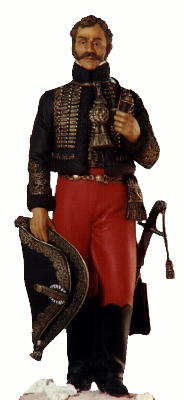
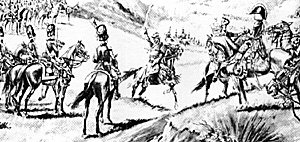
Commanding a light cavalry division in Spain, LaSalle fought successfully at Torquemada, 6 June 1808, Medina del Rio Seco, 14 July 1808, and Medellin, 28 March 1809, where he saved the day by personally leading the 26e Dragons in a charge that broke a Spanish square.
Recalled to Germany, he took command of the 1st Light Cavalry Division under Bessières on 19 May, 1809. In the desperate fighting at Aspern-Essling on 21-22 May, LaSalle led his men with reckless courage in repeated charges against superior numbers of Austrians. He served with Prince Eugène at Raab in June. LaSalle's light cavalry division was attached to Masséna's IV Corps for the climactic struggle at Wagram, 5-6 July 1809. The division fought well, notably riding down the Austrian batteries at Aderklaa on the morning of the 6th. Then, with the Austrian Army already defeated and beginning its withdrawal late in the afternoon, LaSalle was shot through the forehead while leading a charge on the Stammersdorf heights.
Colonel John R. Elting (himself a cavalryman), in Swords Around a Throne, gave this characterization of LaSalle:
Antoine Charles LaSalle was the jingling, carefree idol of most light cavalrymen, the man for high adventure and reckless deeds....He was usually in debt; also, he gaily misbehaved with Leopold Berthier's wife--but then married her after the resulting divorce, and became a model husband and father whose only extramarital pleasures were war and collecting maps and pipes. He had no enemies (Marbot, to whom he once sold a horse, did dislike him) and rode with open heart and open hand. Utterly brave, loving danger, laughing at his own hardships, frequently charging with a long pipe instead of a saber in his hand, he had too much heart and too little head to handle masses of cavalry, and so got himself uselessly killed at the end of the day at Wagram, charging into some Austrian landwehr whom he easily could have surrounded and taken. His trick of the trade was to charge at the trot, holding his men solidly in hand to meet an enemy exhausted from galloping.
Next Page
Return to Index
 LaSalle's squadron of the 7e bis Hussards charged and captured an entire Austrian battalion in the Osteria Gorge. In the aftermath of the battle, as victorious French soldiers were piling captured Austrian standards at Napoleon's feet, it is said that he turned to the exhausted LaSalle and said, "Couche-toi dessus, tu l'as bien mérité" (lie down on those, you have certainly earned it).
LaSalle's squadron of the 7e bis Hussards charged and captured an entire Austrian battalion in the Osteria Gorge. In the aftermath of the battle, as victorious French soldiers were piling captured Austrian standards at Napoleon's feet, it is said that he turned to the exhausted LaSalle and said, "Couche-toi dessus, tu l'as bien mérité" (lie down on those, you have certainly earned it).

 He is credited with saving the life of Davout at the Battle of Redemieh on 17 January, 1799. Returning to France in early 1800, LaSalle was confirmed in the rank of
He is credited with saving the life of Davout at the Battle of Redemieh on 17 January, 1799. Returning to France in early 1800, LaSalle was confirmed in the rank of 
